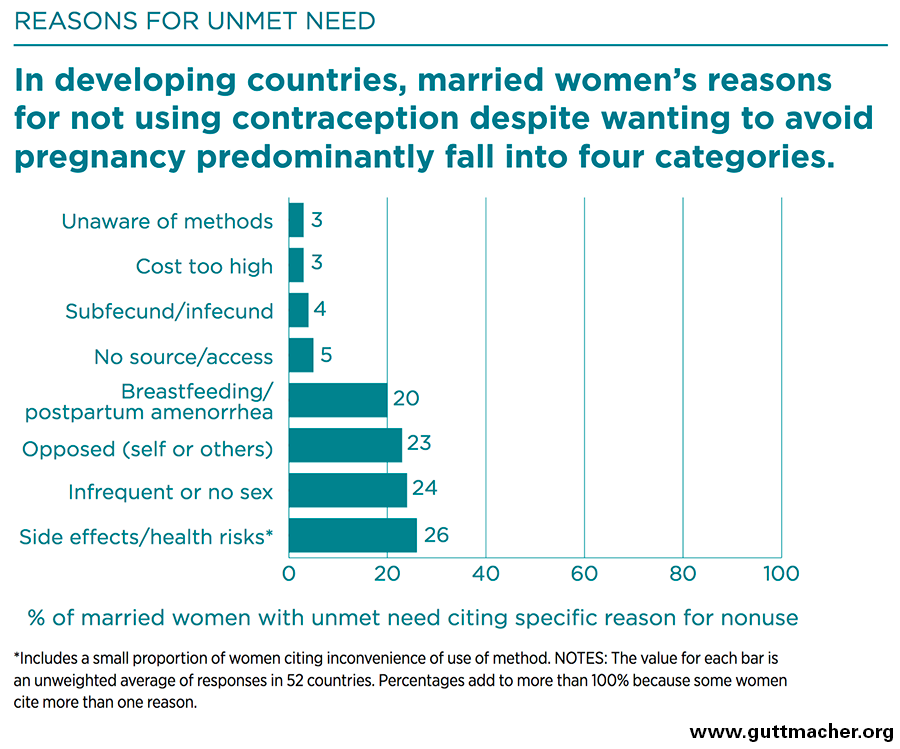Unintended pregnancy and unmet need for family planning: What do these terms really describe?
Written by Olivia Nater | Published: June 30, 2022
Supporters of reproductive health and rights, including us at Population Connection, often highlight the persistently high rates of unintended pregnancy and unmet need for family planning around the world, but these terms are often misunderstood. Let’s dig in to their true meanings.
Unmet need for family planning
Many assume that an unmet need for family planning occurs when women don’t have physical access to contraception, and that’s often the case. But unmet need actually describes the desire (as expressed in responses to 15 different Demographic and Health Survey questions) to avoid pregnancy despite not using contraception for any reason—many of which extend beyond physical access.
Estimates for unmet need vary depending on the geographic area in question and how it is defined – some account for women who don’t use any modern contraceptives, whereas others comprise all types of pregnancy prevention, including traditional methods such as fertility awareness and withdrawal. The latest UN figures estimate that 257 million women globally have an unmet need for modern contraception, meaning they are not using any reliable means to prevent pregnancy. Of these 257 million women, 172 million are using no method at all and 218 million live in low- and middle-income countries.
Research from 2016 by the Guttmacher Institute found that only 5% of women with an unmet need for family planning in developing countries cited lack of access to contraception as their reason for not using it.

This year’s State of the World Population (SWP) report found,
“…lack of awareness about, and lack of access to, contraception are no longer leading causes for non-use. Instead, these barriers are now overshadowed by concerns over side effects, myths, stigma and opposition from others.”
Insufficient high-quality information, as well as widespread misinformation, in part due to no or poor sex education, deter many women from using birth control even if they do have access to it. For example, many women have been misled about real or perceived side effects, such as believing that modern contraception will make them infertile, and as a result either stop using it or avoid it altogether. Harmful patriarchal perceptions of women who use family planning as immoral (especially when they are unmarried) can be a powerful deterrent. Many men also explicitly forbid their female partners from using contraception — horror stories about women being badly beaten and even murdered after visiting a family planning clinic without their partner’s permission remain all too common. Opposition can come from other family members also. In many families in India, for example, mothers-in-law have a big influence on couples’ family planning decisions.
To be effective, international family planning programs must go well beyond service delivery and include outreach and education efforts that promote bodily autonomy, provide good information and challenge harmful attitudes.
While barriers to contraceptive use are highly prevalent and varied in developing regions, women in wealthy countries like the U.S. can also have an unmet need for family planning. A new Guttmacher study on U.S. women with low incomes revealed that, if cost were not a factor, 39% of non-users would start using contraception, and 23% of users would choose a different contraceptive method. Additionally, lack of quality sex education and, in many school districts, a reliance on abstinence-only education is an important reason for non-use, especially among U.S. teens.
Unintended pregnancy
An unintended pregnancy is a pregnancy that is either mistimed or unwanted at the time of conception. Mistimed pregnancies are different from unwanted pregnancies in that they may have been wanted at a different time. Unwanted pregnancies are those that aren’t desired regardless of timing. Both mistimed and unwanted pregnancies often result in people seeking terminations — 60% of unintended pregnancies end in abortion.
 Unmet need for family planning drives unintended pregnancy, and rights violations like forced marriage and rape remain tragically common. According to the UN, a third of women and girls globally are subjected to gender-based violence during their lives, while in low- and middle-income countries, one-in-four feel unable to turn down sex, and one-in-ten have no say over whether they use contraception. As no birth control method is 100% effective, contraceptive failure is another very common reason for unintended pregnancy.
Unmet need for family planning drives unintended pregnancy, and rights violations like forced marriage and rape remain tragically common. According to the UN, a third of women and girls globally are subjected to gender-based violence during their lives, while in low- and middle-income countries, one-in-four feel unable to turn down sex, and one-in-ten have no say over whether they use contraception. As no birth control method is 100% effective, contraceptive failure is another very common reason for unintended pregnancy.
“The number of unintended pregnancies that occur every year — 121 million, or 331,000 per day on average — represents a global failure to uphold a basic human right. And that failure is expected to grow. While recent data also show that, worldwide, the unintended pregnancy rate fell between 1990 and 2019, continued global population growth means that the absolute number of unintended pregnancies will keep rising without decisive action.”
As with unmet need for family planning, unintended pregnancies are not restricted to developing regions. In fact, the U.S. has the highest rate of unintended pregnancy among wealthy nations — 45% of all U.S. pregnancies are unintended, equivalent to the global average. Unintended pregnancy in the US disproportionately affects women with low incomes, women with low educational attainment, and women of color. Persistently high rates of unintended pregnancy reinforce the importance of easy access to safe abortion services, both nationally and around the world.
The funding gap
Reliable data on unintended pregnancy and unmet need is key to developing suitable national and international family planning programs that address their root causes. Satisfying the current unmet need for modern contraception of the 218 million women in developing countries would cost a total of $12.6 billion annually, according to the Guttmacher Institute. Based on the wealth of the U.S., its share should be $1.74 billion, yet in recent years, the government has been meeting only around a third of this target – it’s essential that we scale up funding for reproductive health and rights around the world.

